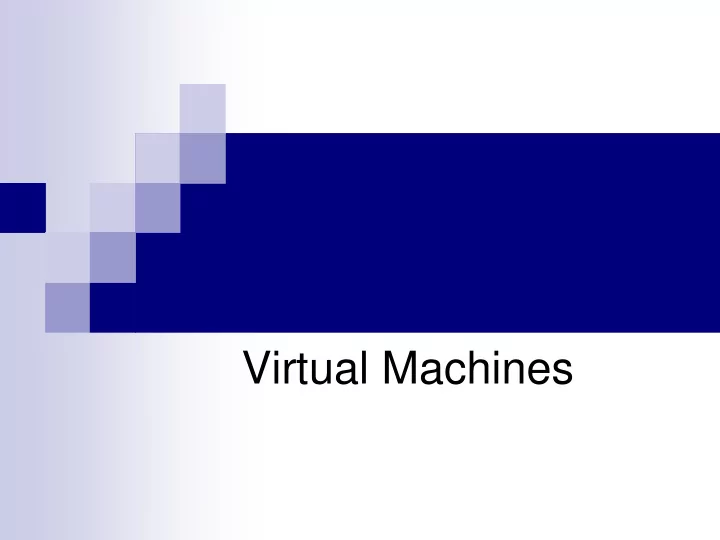

Virtual Machines
What is a Virtual Machine? Java Virtual Machine (Application Virtualization) Software to simulate hardware Independent ‘Separate’ Use one piece of hardware to simulate many computers
Topics What are Virtual Machines? Why are they related to security? Getting past Virtual Machines
Flavors of Virtualization Hardware Virtual Machine Emulation (full system virtualization) Complete hardware virtualization. Unmodified Guest OS for a different CPU can run Native Virtualization (full virtualization) Simulates hardware to run to run an unmodified OS, but OS has to be for the same type of CPU
Application Virtual Machine (Paravirtualization) Does not simulate hardware, but offers API that requires OS modifications like JIT compilers or interpreters Virtual Environment (Virtual Private Server) Used to run applications, doesn’t simulate a kernel Operating System-Level Virtualization
Machine Aggregation (clustering) Use number of different computers to simulate a more powerful single machine Parallell Virtual Machine (PVM) Message Parsing Interface (MPI)
Why use it? Running multiple operating systems Physical space Mobility (USB Drives) Sandboxing Honeypots
Hypervisor / VMM Platform allowing multiple operating systems to run Abstraction layer for a virtual machine Equivalence Resource Control Efficiency
Virtualization Requirements Popek and Goldberg Virtualization Requirements Instruction Set Architecture must possess: Operate in user mode or system mode Uniformly addressable memory (relative to a register) All instructions affecting the functioning of the VMM are controlled by the VMM
A computer is virtualizable if it is virtualizable or a VMM without timing dependencies can be constructed for it. (Recursive) x86 processors compliant: Intel Virtulization Technology (IVT) Most P4, Pentium D, Xeon, Core Duo, Core 2 Duo AMD Virtualiation (AMD-V, Pacifica) K8, all F’s and onwards
Explanation of the Diagram Kernels manage CPU, Memory and devices and interfaces them with applications VMM splits the left and right side to keep them isolated Ring level determines the amount of ‘power that layer has
Sandboxing Installing new infrastructure software Installing downloaded software on the net Browsing Security – Undo Disk in VPC
Honeypots Used to detect malicious users Set up a VM network Let someone attack your system, then watch them, since no useful information is being stolen Only software layer being attacked
Misconceptions Virtual Machines aren’t an end -all security guarantee Software still using CPU and memory of host machine Equivalence, Resource Control and Efficiency aren’t always completely achieved
Detecting a VM Run loops on remote machine suspected to be a VM Loops contain commands a certain VM (Xen, VMWare) don’t do particularly well Run Loop they do well Detect differences of speed opposed to non- VM’s
Java Virtual Machine Attack Attacking a JVM that permits untrusted code to execute after it’s verified to be type-safe Sending JVM a program and waiting for a memory error Once it type-checks, it rearranges the memory so the type system is defeated
The program Class A { Class B { A a1; A a1; A a2; A a2; B b; A a3; A a4; A a4; A a5; A a5; int i; A a6; A a7; A a7; } }
Memory Error The i th bit of a word is flipped for some reason If 2 i is larger than the object size, x xor 2 i is likely to point to the base of a B object. Then, there is an object with type A that actually points to a B object
Exploiting the Memory Error A p; offst is the offset of the field i from the object A B q; i and a6 of object B are int offst = 6*4 equal offsets from their void write(int addr, bases int value) { If p and q are at the same p.i = addr – offst; address, the second q.a6.i = value; statement writes at the } offset of an offset value is written at offst + (addr – offst) = addr
Results This lets anyone calling write() to write value v into address a Fill an array with machine code Overwrite a virtual method table with the address of the array Remote code execution
VMware Attack NAT in VMware was not validating PORT and EPRT commands from FTP Specially formatted commands allowed heap-based buffer overflow Vulnerability allowed attacker to execute code on host machine
Recommend
More recommend